#Iron Age Archaeology
Text

Iron Age Vessel Fitting And Chain (Likely For Hanging Items Over A Fire), The National Museum of Scotland, Edinburgh
#ice age#stone age#bronze age#copper age#iron age#roundhouse#settlement#metalwork#metalworking#ancient cultures#ancient living#ancient design#Scotland#hearth#iron age archaeology#Edinburgh
46 notes
·
View notes
Text
Tablet weaving

Tablet weaving or Card weaving is a weaving technique used for belts or trims. Instead of weaving on a loom, a certain amount of yarn lengths are placed through cards, with the yarn being tightened between a post and the weaver's own body. The pattern being created by turning the cards in a certain direction.
Tablet weaving has been around since the Iron Age, with the oldest examples being found in Hallstatt, Austria dated around 1200 B.C. (3200 years old), and was commonly used in European dress until the Viking age (1000 A.D.). The use later declined with mass produced textiles on big looms being more and more common. Scientists have no idea how patterns were invented or taught to new weavers. No examples of written patterns exist from this 3500 year time span.
Image copyright and content:
Hallstatt and Dürnberg textile remnants, Regina Hofmann-de Keizer
#frankish#merovingian#viking archaeology#archaeology#carolingian#charlemagne#field archaeology#viking mythology#germanic mythology#merovingian archaeology#celtic#germanic#hallstatt#durnberg#dürnberg#celtic archaeology#iron age#Iron Age archaeology#tablet weaving#card weaving#dress history#celtic dress#celtic fashion#viking fashion#viking#norse mythology#odin#wodan#cernunnos#anglo saxon
191 notes
·
View notes
Text
so. um. the good news is we found your boyfriend. the bad news is that, well, we sort of…dug him up…in the middle of a car park. in leicester (buckley et al. 2013). leicester, yeah. sorry. they demolished the friary he was hastily interred in when henry viii dissolved all the monasteries. you know how it is. and as it turns out, well, shakespeare was…sort of right about him. scoliosis, yeah, sorry (appleby et al. 2014). if it makes you feel any better we analysed his bones and it turns out he had a pretty high-protein diet before he died (lamb et al. 2014). and he drank so much wine that it changed their chemical composition, which we didn't know could actually happen before we analysed him (lamb et al. 2014), so he was having a good time, at least.
BIBLIOGRAPHY
Appleby, J., Mitchell, P.D., Robinson, C., Brough, A., Rutty, G., and Morgan, B. (2014). The scoliosis of Richard III, last Plantagenet King of England: diagnosis and clinical significance. Lancet 383, 1944.
Buckley, R., Morris, M., Appleby, J., King, T., O’Sullivan, D., and Foxhall, L. (2013). ‘The king in the car park’: new light on the death and burial of Richard III in the Grey Friars church, Leicester, in 1485. Antiquity 87, pp. 519-538.
Lamb, A.L., Evans, J.E., Buckley, R., and Appleby, J. (2014). Multi-isotope analysis demonstrates significant lifestyle changes in King Richard III. Journal of Archaeological Science 50, pp. 559-565.
#found this in my drafts thought it was still funny#archposting#richard III#archaeology#alevelposting#<- contains tudors memes#i've actually met one of the cited authors here they were very cool. we weren't talking about riii though (iron age greece)
14K notes
·
View notes
Text
Iron Age Hut Circles in the Middle of Nowhere: Submerged Prehistory in Upper Glen Cannich
by Roland Spencer-Jones
Does every excavation and discovery have a story behind it? Maybe. This one certainly does. When did the story start? With shepherds moving into empty land in the early 19th century? With the gradual depopulation of Highland glens in the early half of the 20th century? With the construction of the largest dam in Scotland completed in 1952?
Maybe it’s best to start this…

View On WordPress
#Allt Nead#CARD fund#cup marked stones#Data Structure Report#Handled stone bowl Inverness Museum#hut circle central hearth#hut circles#iron age archaeology#Loch Lungard#loch mullardoch#North of Scotland Archaeological Society#radiocarbon dates#recording and surveying#rock art
1 note
·
View note
Text

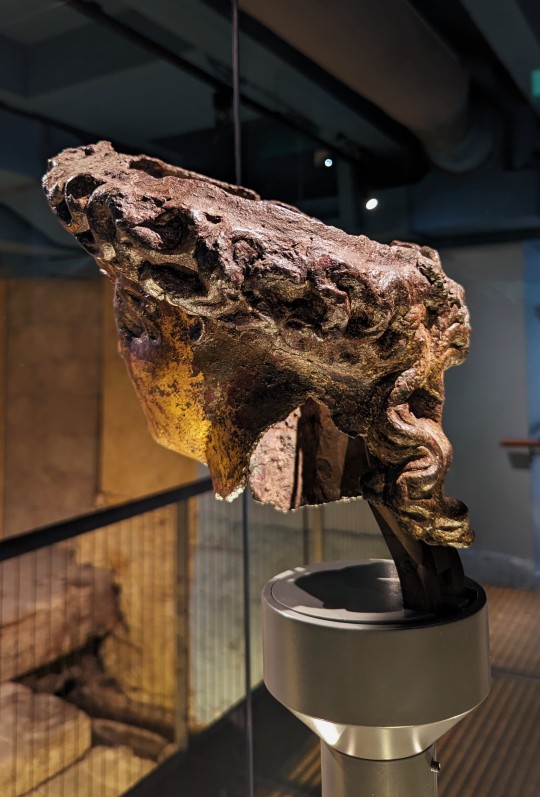
Bronze Head of Sulis Minerva from the Bath, England dated to the Late 1st Century on display at the Roman Baths Museum in Bath, England
This bronze head was discovered in 1727 and was an early indication that the Roman site at Bath was not a typical settlement. Gilt bronze sculptures are rare finds from Roman Britain as only two other fragments are known.
The head is probably from the cult statue of the goddess which would have stood within her Temple beside the Sacred Spring. From there she may have looked out across the Temple courtyard to the site of the great altar, the site of sacrifice, which stood at the heart of that sacred space. The statue may well be an original object from the foundation of the site in the later first century CE, which means that it was probably well over 300 years old when it met its demise.
The head is slightly larger than life size, suggesting that the original statue was an imposing sight. Hidden in the hair line are several small holes which once held rivets that fixed her tall Corinthian helmet to her head.
Examination of the head has revealed that it has six layers of gilding. The first two use a technique known as fire gilding whilst the four later layers are applied as gold leaf. The head has a number of imperfections. There is corrosion which has affected it in parts where it lay in the ground for over a thousand years. There is also a strange rectangular cut beneath the chin. It is thought that this may result from a flaw in the original casting process in which a bubble on the surface may have been cut out and filled with an inserted plate. When gilded over it would not have been visible. This plate has subsequently fallen out as a result of corrosion whilst in the ground.
Photographs taken by myself 2023
#art#archaeology#history#roman empire#english#england#ancient#iron age#roman baths museum#bath#barbucomedie
199 notes
·
View notes
Text

The Himlingøje Woman
Roman iron age grave from Himlingøje, Denmark. She died in her 40s or 50s and was buried with many treasures both local and imported.
i also did a version of the whole grave where everything is in its proper place and not shuffled around like this, but its an odd shaped image for tumblr. will probably post that one later : )
Based on photo by Roberto Fortuna and Kira Ursem from natmus.dk
#iron age#skeleton#grave#archaeology#illustration#denmark#roman iron age#himlingøje#roman glass#archeology
236 notes
·
View notes
Photo



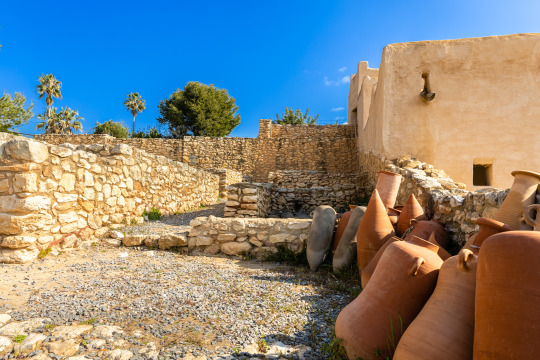

The archaeological site Iberian Citadel of Calafell (Penedès, Catalonia) was a fortified residence built by the Cessetani people (one of the Ancient Iberian peoples) and inhabited between the 6th and 2nd centuries BC. Its destruction was probably due to the Roman occupation.
A part of the archaeological site has been rebuilt in the original techniques to serve two purposes: one, it allowed archaeologists to research the building methods through experimental archaeology; and two, to show what an Ancient Iberian village from around the year 200 BC would look like. You can see the result in these photos: the foundations and lower part of the walls are made of stone to keep out the humidities from the ground, and the rest of wall is made of rammed earth, with ceilings using wooden beams and reed fences. The research focused on those elements that rarely leave a trace, for example the inclination of the roofs (when the walls and roofs are made of a material that doesn't resist the passage of time, like rammed earth) and water draining.
Photos from Enoturisme Penedès and Visit Calafell. You can find the results of the reseach in the article linked here.
#arqueologia#història#calafell#catalunya#ancient iberians#archeology#archaeology#antiquity#iberian#culture#history#historical#travel#europe#southern europe#protohistory#iron age#experimental archaeology#archaeological site#ancient iberian#ancient
70 notes
·
View notes
Note
Hey, I noticed that in one of your posts you showed an Iron Age Finnish woman's dress. Would you happen to have a good idea of what Finnish men were wearing in that era? The information on it seems sparse. I do have a relevant book that I'm about to look through, but I'd like to hear your insight too!
Hi! Thanks for the question (and sorry for the slow answer), I do love Finnish Iron Age clothing so it's always my pleasure to write about it. I've been wanting to do a deep dive into this for a long while, so maybe I'll do at some point a post about women's dress too.
Unfortunately no one has good idea of the Finnish Iron Age men's dress (and if you find any book or other source that claims otherwise, do not trust it), since there's much fewer archaeological finds of men's dress than women's dress. The most accepted theory on why the textiles of women's dress survived surprisingly well is because of the bronze ornamentation commonly sewn into especially the fine women's dresses of the era. The bronze protected them from decomposing fully. Presumably men's dresses were not decorated similarly then. There are some finds though and we can piece together at least some kind of vague picture.
I will be discussing the period from Viking Age to Crusade Age in Finland. Viking Age is often defined to cover 800s to mid-1000s and the Finnish Crusade Age started right after the Viking Age and ended in the end of 1200s, where the Finnish Medieval era begins. Crusade Age refers to the period where mostly Swedish (also German) crusaders in the span of couple of centuries conquered lands of the Baltic-Finnic pagans. The crusades of this period targeted pagans all over eastern Baltic Sea, including Baltic-Finnic Karelians, Livonians and Estonians, and Baltic peoples, and the Scandinavia too, where Sámi people were targeted. After that the Finland and Sápmi were colonized by Norse people and stayed that way untill Finland was transferred under Russian rule, but to this day Sápmi still stays under colonial rule, including Finnish colonial rule. The current Finland was very multicultural area, mostly populated by Finno-Ugric peoples, including Sámi people, Karelians and various Finnish peoples.
It's important to understand that even just Finnish peoples where not homogeneous, but had distinct, yet of course strongly related cultures. These were Finns (suomalaiset) (yes most people we now call Finns were not in fact called that) in the coast of southwestern and western Finland, Tavastians (hämäläiset) in central-western lake-Finland and Savonians (savolaiset) in central-eastern lake-Finland. This means we can't mix findings from all over Finland to reconstruct a dress without evidencing that all the elements were actually used in one place. These three tribes had broadly similar base for their clothes, but distinctive jewelry and detailing. The big divide was and has always been between eastern and western Finnish peoples. This is because western Finnish people were in close contact through the sea with Norse people and southern Baltic-Finnic peoples, while eastern Finnish people, Savonians mostly, were influenced a lot by their proximity with Karelians. Another dividing factor was the very different environmental conditions between western and eastern Finland. The Finnish coast especially in west is very flat and fertile land, while the lake area, especially in eastern Finland is very rocky, hilly and quite infertile. The main way it effected clothing differences was that western Finland being more wealthy had more elaborate clothing. Tavastians in both occasions fall quite in between, but they tended to be more in the western cultural camp.
My most important sources are a study by a doctor of cultural anthropology, Jenny Kangasvuo, Savon historia I (Savonian history) digitized and open sourced here and the digitized archeological collection of Finnish Heratage Agency. They are all in Finnish so not very useful for most people unfortunately.
Finnish Men's Dress in Viking and Crusader Ages
The basic garments men wore were broadly similar as women. They wore a shift/shirt, knee or above-knee length dress, cloak, belt, shoes and some kind of headwear. Wool was used most commonly, though the shirt would sometimes be linen too. Even evidence of silk has been found in some western Finland graves. I would assume that would be from a dress of some great man, who traveled to gain riches, possibly with vikings. Embroidery and decoration with metals was a typical feature of the whole Eastern Baltic Sea area. In Finland during this period bronze was the most common decorative metal, but silver was used too. Decorative elements were usually woven with small bronze spirals into all kinds of patterns. Here's examples from the reconstructed Ravattula's dress (Finns) used by women.
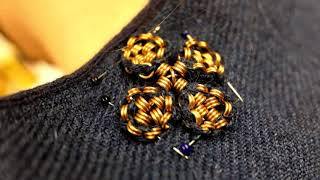

Shirt
The shirt (in Finnish shift of both women and men was called shirt) was basically a long shirt or under dress. We can assume it was similar to those of women's except shorter since the dress men wore was shorter too. They were made from wool or linen, I would assume wool was used in winter and linen in summer, when linen was even available. The neckline had a cut and closed with a bronze brooch. Horseshoe brooch was common. The first one is a quite typical bronze horseshoe brooch with a bit of ornamentation from Salo (Finns). The second one is from Tuukkala, (Savonians), it has exceptional ornate detailing and is uncommonly silver, not bronze. The third picture has two quite uniquely ornamented horseshoe brooches, first from Köyliö (Finns), second from Kurikka (Finns).
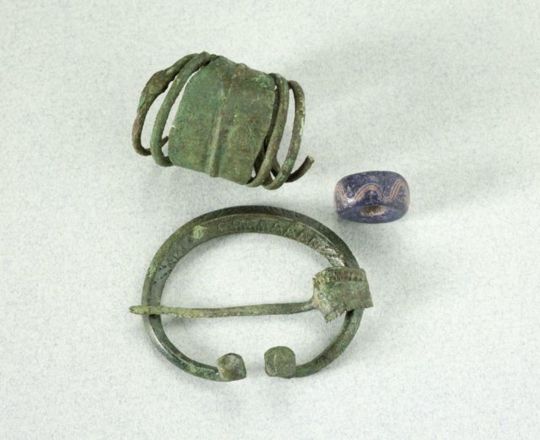
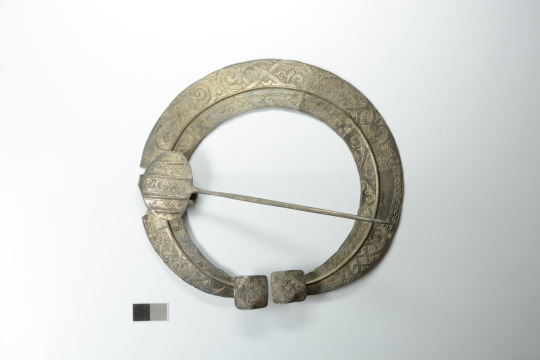
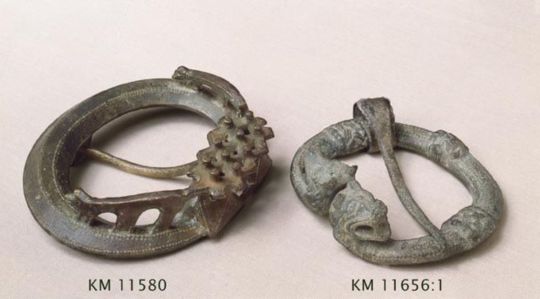
Legwear and footwear
Very little of men's legwear has survived and it's unclear weather men wore pants or separate pant legs, leg wraps or perhaps long socks. Evidence of strings decorated with bronze spirals and tablet woven band has been found in leg area of men's graves. This could mean that they wore either leg wraps, long sock or some sort of pant legs that needed to be secured with string or band under knee. Women used strings and tablet woven tape to secure leg wraps and socks, which I think supports that theory. Sometimes both bronze decorated string and tablet woven band was found in the leg area, which would still be explained by this theory, since it was common to decorate the ends of the bands with bronze decorated strings. Here's an example of sock bands just like that from the earlier mentioned reconstruction of the Ravattula's women's dress. Since men's dress was shorter, I think it would make sense if they still wore some kind of pants or separate pant legs with socks or leg wraps like that.
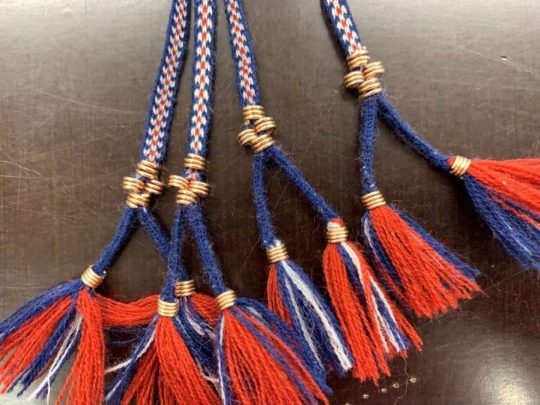
However, the strings and bands could have also been part of the shoes. Everyone probably wore similar shoes - laced leather shoes with a bit of pointed end. They might have been short or ankle length and the lacing was done with either leather cord or tablet woven band, which would also explain the findings. Socks or feet wraps would have been used in them, and straw or wool could be added as filling for warmth. Here's a pair of traditional Izhorian shoes from Estonia from early 1900s, and a pair of traditional Sámi shoes. The designs were likely roughly similar in Viking and Crusader Ages, though obviously more simple, and it's probable that Finnish shoes very something like that too. Here's a 1893 drawing of what findings of shoe material from Korpiselkä (Savonian or Karelian) might have looked like. Considering the quality of archaeology of that time, copious amounts of salt should be applied. And finally as a fourth picture there's reconstruction shoes from Ravattula's dress.


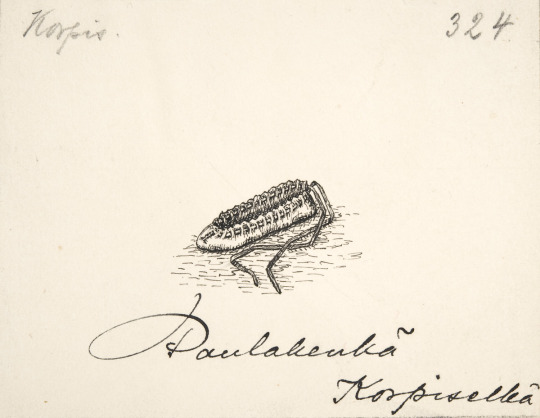
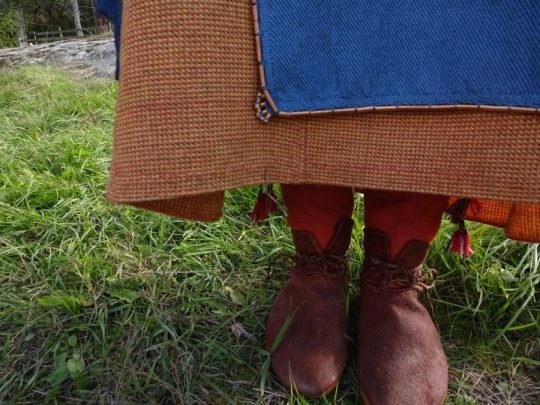
These are not necessarily mutually exclusive theories. The lacing of the shoe could have been laced up the leg and used also to secure either sock or leg wrapping, or they could have been separately secured in ankle and knee respectively.
In some graves twill fabric has been found in the leg area. It could be part of pants or for example leg wrapping, which was often made of twill. One theory about pants is that they were similar as some findings in Sweden, where fairly tight pants made of twill were secured at the hem with buttons similar to cuff studs. These kinds of cuff stud buttons are quite a common find in Finland and some have been found in men's graves close to legs.
Dress
Again there's not much findings of dresses, but a little more perhaps. It was usually from wool. The shape was either a tunic or an open coat. In Karelia there's findings of men's dress suggesting tunics thicker than women's dresses and made from sarka, a type of broadcloth. On the other hand, in Masku (Finns) they found buttons in a row on top of the torso, which suggest a coat closed with buttons. The first picture is a drawing of the grave find. Similary coak closing amounts of buttons have also been found in other places in western Finland. This suggests that Finns and probably Tavastians too wore long coats buttoned to the waist and Savonians wore tunic of Karelian influence. Below there's couple of version of what might this western Finnish men's coat dress could've looked like. The first is an imagined version of the coat based on the Masku grave finds, second is just as imagined version based on Eura (also Finns) grave finds.
Take these "reconstructions" with a strong dose of salt. These are more artistic reconstructions than scientific, since there's not enough material and too much guesswork needs to be done. And because we can see in the Masku grave drawing right here that the other deceased has a large buckle to (probably) close the shirt (to be fair, it could for a cloak too), like was typical, I find it implausible that the coat neckline would be small and round covering the buckle. If you make a decorated big buckle, I assume you want to show it. I would find a v-neckline more probable. It's also easier to make without wasting expensive fabric.

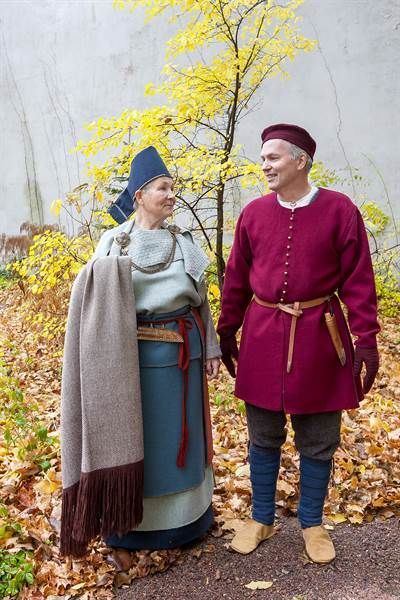

The buttons are interesting. There were what you would imagine - your typical buttons made of bronze like seen in the first artifact from Hattula (Tavastians). But then there was silver jingle bells used as buttons, found for example in both Masku and Eura graves, Eura findings pictured below.


It's possible, even probable I'd say, that the hemlines of men's dresses were finished with tablet weaving patterns, like women's dresses. Also I would assume the pattern of the men's dress (and shirt) was mostly similar to the women's underdress/shirt patterns. So here's couple of different reconstruction patterns for women's dress. Different historians have made different interpretations of the patterns, so it's very much undecided what it really was like.
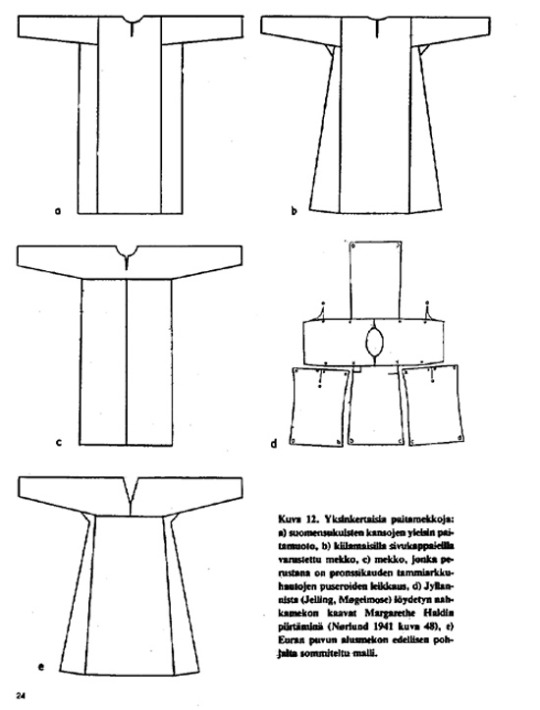
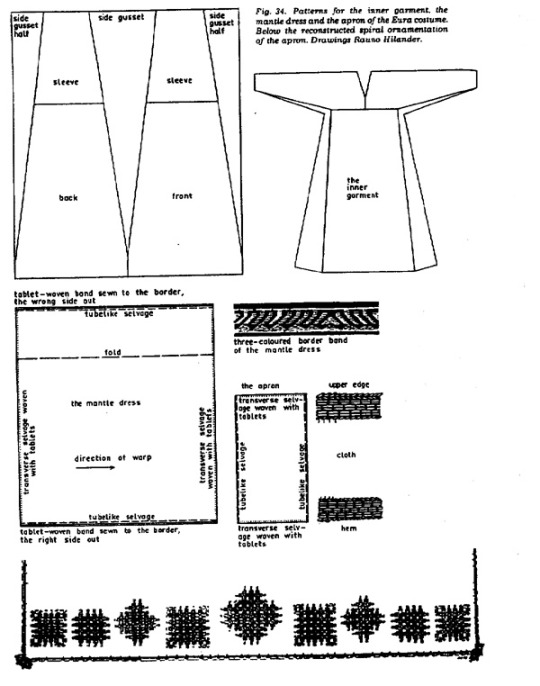
Belt
This is likely the most ornamental part of men's dress. They could be made out of leather or tablet woven band. And there's another east-west cultural divide here. Karelian belts were made out of leather, were usually 1,5-2,5 cm wide, decorated with iron or bronze studs and had a buckle made out of iron or bronze. These types of belts have been found in Savonia too, for example in Tuukkala grave find, which you can find very cool pictures of in this photo documentation of the dig in pages 173-175. In western Finland a "hela" belt was the common style. I don't think there's a world for hela in English. It's a sort of decorative lamella, small metallic plate (not necessarily square but often so) attached to fabric or leather with studs or sewing. Hela belt came from the Permians of Kama river, who were one of the many Finno-Ugric peoples who used to populate much of European side of Russia. Karelians lived closer to Permians, so you might think Permians would influence eastern Finland more, but my theory is that the costal Finns, who frequently joined viking crews and at least were in close contact with merchants including vikings, who would travel along the eastern route through the eastern European rivers, where they could go all the way to Kama river or at least meet traveling Permians. Here's yet another Finnish source more on the Finno-Ugric people around Kama river.
Anyway, hela belt was made of leather and filled with small decorated lamellas, often in square shape, but various other shapes too, like animal ornamentation. In this period hela belt helas were bronze. First image is a nice full set of hela belt metal pieces found in Pirkanmaa (Finns). Second is an older example, right before Viking Era, from Vaasa, costal settlement, (Finns), depicting a very Permian style. The third one is a lion hela found separately in Pälkäne (Tavastians). They are also found in Tuukkala, showing that both eastern and western cultural influences were present there at the same time.

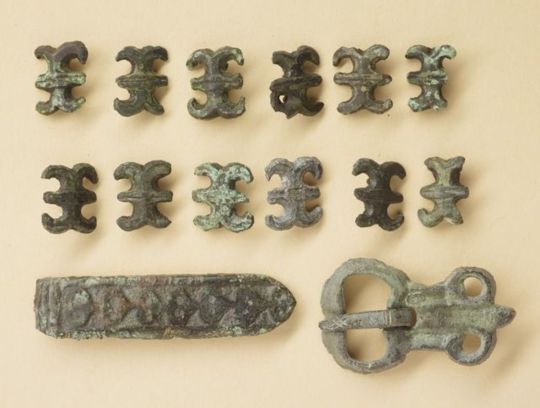
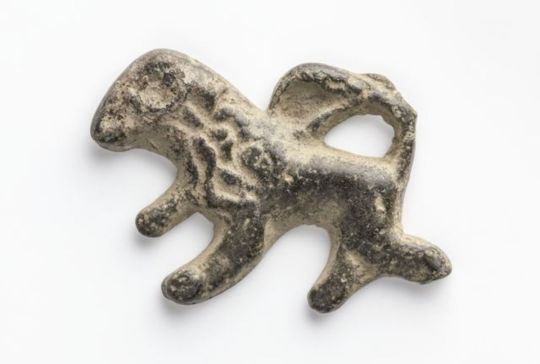
Another western Finnish belt type for men had intricate tassels decorated with bronze spirals hanging on the waist at the end of the belt. They could be made out of leather or tablet woven band. First image depicts a reconstruction of such tassel. Belts in east and west would have strap dividers to hang straps for things like purse, knife and sword. The first picture above has couple of those, but the second picture below has two more of them in more detail in the middle of the picture. These finds are from Lieto (Finns).


Cloak
Like women's cloak, men's cloak was woolen and either a square or trapezoid. Cloak is yet another east-west divide. In western Finland men's cloaks have embroidery with bronze spirals. They in fact appeared earlier in men's cloaks (in 900s) than in women's cloaks (1100s). They were also a little different in men's cloaks. The spirals and the patterns themselves were bigger and the fastening thread itself was also used for the pattern creation, unlike in women's dresses, where the thread was mostly covered. In eastern Finland there has been no finds of bronze decorations in men's cloaks, mostly only cloak brooches have been left of them. Unsurprisinly same applies to Karelia. This also means there's very little fabric left too. There's one exception. In Tuukkala (Savonians) they found a piece of fabric probably from men's cloak, though it could be from a men's dress too. It was striped, with possibly white or brown base and wide stripes of red, blue and yellow. So perhaps eastern Finnish cloak was not non-decorated, but the decoration was in the fabric pattern. Unfortunately it's hard to know how common fabric like that was, when so little of it is left.
Accessories
It's safe to assume men too wore some type of headwear, but none of those has survived. It probably means it was entirely made out of fabric whatever it was. Some type of hat or cap was certainly used in cold weather at the very least. Tablet woven headband was also possible option for not too cold weather.
In Tuukkala there was couple of interesting jewelry finds too. Two graves had a necklace type mostly found in Karelia. It was birchbark tape covered with nettle fabric and had square helas sewn into it. There were also more typical Finnish necklaces made of beads and bronze spirals.
Razors have also been found with men in their burials, so we can assume shaven faces or at least trimmed beards and moustaces were fashionable.
#dress history#historical fashion#historical clothing#fashion history#history#iron age dress#finnish iron age dress#finnish history#archaeology#answers#anon
224 notes
·
View notes
Text

Ancient Celtic Helmet Is the Oldest Ever Found in Poland
Unearthed at the Łysa Góra archaeological site, the artifact, some 2,300 years old, is a prime example of Celtic metalworking
Archaeologists in Poland have unearthed a horde of 300 artifacts dating back to the fourth century B.C.E. Found at the Łysa Góra site in the region of Mazovia, near Warsaw, the trove includes iron axes, scissors and, most notably, a rare Celtic helmet.
A team from Warsaw’s State Archaeological Museum and University of Warsaw’s Department of Archaeology has been excavating in Łysa Góra since the spring. According to a statement by the team, the helmet was buried in a charcoal pit, along with four iron axes.
Though it was damaged by age, researchers determined the “spectacular” helmet was originally shaped like a cone, possessing a separate curved neck piece and decorated with etched lines. Its discovery has changed the team’s perceptions of the Celts—a group of Central European tribes who thrived during the Iron Age, from 1200 B.C.E. until 50 C.E.

The helmet is the first artifact of its kind to be found in Poland, as excavation leader Bartłomiej Kaczyński, of the archaeological museum, tells Science in Poland’s Ewelina Krajczyńska-Wujec. Before, only one other, much newer Celtic helmet had been discovered: a first-century piece found in the southern village of Siemiechów. The Łysa Góra helmet is at least 2,300 years old.
“At first we thought it might be some kind of ancient vessel, because bronze vessels are much more common on Polish soil than helmets,” Kaczyński tells Science in Poland, per Newsweek’s Aristos Georgiou. Then, the artifact’s neck piece—an arched plate near its edge—prompted archaeologist Andrzej Maciałowicz to suggest it could be a helmet.
Based on the artifact’s shape, and the fact that its tip was held together by a double knob, researchers concluded the piece is an early La Tène helmet. The Celtic culture of La Tène—French for “the shallows”—is named for Lake Neuchâtel in Switzerland, where researchers first found La Tène objects in the late-1800s, per ARTnews’ George Nelson. The culture formed around the fifth century B.C.E., about when Celts came into contact with Etruscan and Greek people from south of the Swiss Alps.
The La Tène style of metalworking developed between the fourth and third centuries B.C.E., and examples of it are “very rare,” per Science in Poland. While 1970s and ‘80s excavations at Łysa Góra revealed some small La Tène artifacts, researchers assumed they ended up in Poland via trading.
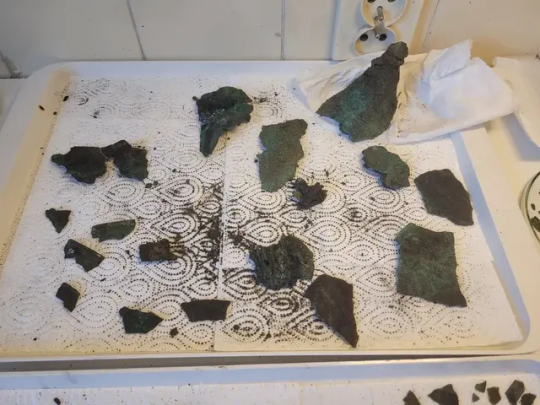


The recently discovered helmet, on the other hand, is an example of “the most advanced Celtic metallurgy,” Kaczyński says, and the piece was seemingly owned by a Celt, per Newsweek. The La Tène helmet’s presence in northern Poland changes researchers’ perceptions of the reach of the Celtic world in the pre-Roman period.
The other artifacts the research team found illustrate the ancient Celts’ proclivity for animal husbandry and farming: Blades from shears might have been used to cut sheeps’ wool, and scythes might have cut grain or grass. According to a statement by the archaeological museum, the researchers also found a collection of glass, amber and stone artifacts, including jewelry—bracelets, ornate necklaces and rings.
The helmet was taken to the State Archaeological Museum’s conservation department, where an expert in iron and bronze artifacts will spend several months conserving its pieces. As Kaczyński tells Science in Poland, the research team began excavating Łysa Góra to help construct an educational trail through the site. But the team’s “multitude of discoveries” indicates they may have more archaeological work to do than they thought.
By Sonja Anderson.

#Ancient Celtic Helmet Is the Oldest Ever Found in Poland#Łysa Góra archaeological site#war helmet#La Tène helmet#ancient artifacts#archeology#archeolgst#history#history news#ancient history#ancient culture#ancient civilizations#iron age#celtic history
43 notes
·
View notes
Text

Remnants of a ringed iron age hill fort built at Old Sarum, dated to 400 B.C., plus later structural remnants, in Salisbury, England.
962 notes
·
View notes
Text



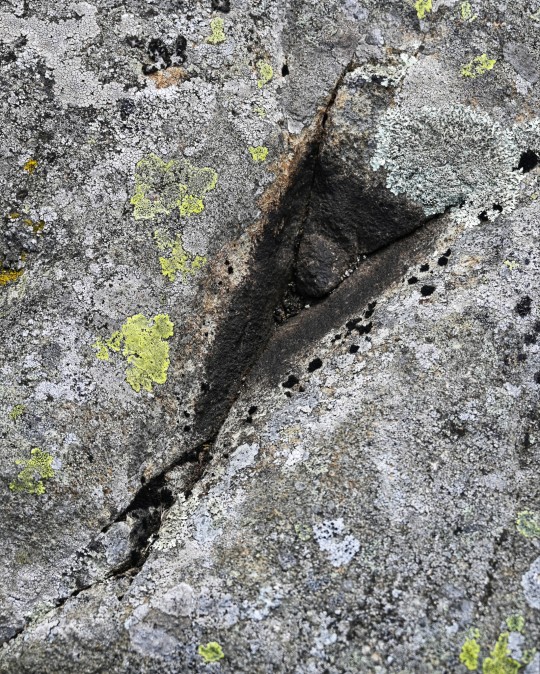
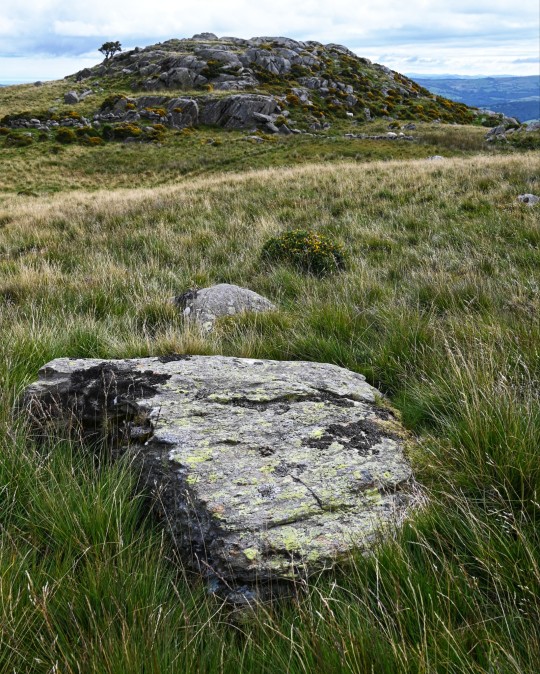
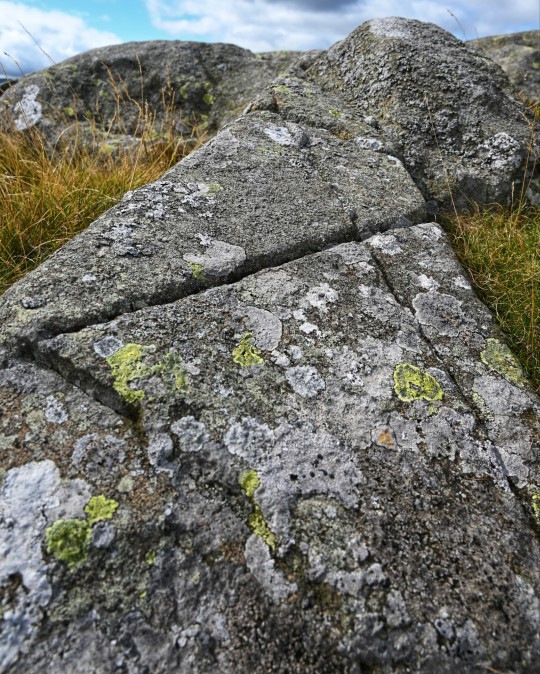

Craig Celynin Ancient Landscape, nr. Rowen, Conwy Valley, Wales
#ice age#stone age#bronze age#copper age#iron age#neolithic#mesolithic#calcholithic#paleolithic#prehistoric#prehistory#landscape#wales#archaeology#geology
4K notes
·
View notes
Text

~ Votive statue of a man.
Culture: Cypriot
Period: Iron Age, Archaic
Date: 550-525 B.C.
Place of origin: Pyla, Cyprus
Medium: Limestone; remains of paint
#ancient#ancient art#history#museum#archeology#ancient sculpture#ancient history#archaeology#votive statue of a man#statue#Cypriot#pyla#cyprus#a#archaic#iron age#550 b.c.#500 b.c.
666 notes
·
View notes
Text
Did the ancient Celts really paint themselves blue?
Part 1: Brittonic Body Paint




Clockwise from top left: participants in the Picts Vs Romans 5k, a 16th c. painting of painted and tattooed ancient Britons, Boudica: Queen of War (2023), Brave (2012).
The idea that the ancient and medieval Insular Celts painted themselves blue or tattooed themselves with woad is common in modern culture. But where did this idea come from, and is there any evidence for it? In this post, I will examine the evidence for the use of body paint among the ancient peoples of the British Isles, including both written sources and archaeology.
For this post, I am looking at sources pertaining to any ethnic group that lived in the British Isles from the late Iron Age through the early Roman Era. (Later Roman and Medieval sources will be discussed in part 2.) The relevant text sources for Brittonic body paint date from approximately 50 BCE to 100 CE. I am including all British Isles cultures, because a) determining exactly which Insular culture various writers mean by terms like ‘Briton’ is sometimes impossible and b) I don’t want to risk excluding any relevant evidence.
Written Sources:
The earliest source for our notion of blue Celts is Julius Cesar's Gallic War book 5, written circa 50 BCE. In it he says, "Omnes vero se Britanni vitro inficiunt, quod caeruleum efficit colorem, atque hoc horridiores sunt in pugna aspectu," which translates as something like, "All the Britons stain themselves with woad, which produces a bluish colouring, and makes their appearance in battle more terrible" (translation from MacQuarrie 1997). Hollywood sometimes interprets this passage as meaning that the Celts used war paint, but Cesar says that all Britons colored themselves, not just the warriors. The blue coloring just had the effect (on the Romans at least) of making the Briton warriors look scary. The verb inficiunt (infinitive inficio) is sometimes translated as 'paint', but it actually means dye or stain. The Latin verb for paint is pingo (MacQuarrie 1997).
The interpretation of vitro as woad is supported by Vitruvius' statements in De Architectura (7.14.2) that vitrum is called isatis by the Greeks and can be used as a substitute for indigo. Isatis is the Greek word for woad; this is where we get its modern scientific name Isatis tinctoria. Woad and indigo both contain the same blue dye pigment, hence woad can be used as a substitute for indigo (Carr 2005, Hoecherl 2016). The word vitro can also mean 'glass' in Latin, but as staining yourself with glass doesn't make much sense, it's more commonly interpreted here as woad (Carr 2005, Hoecherl 2016, MacQuarrie 1997). I will revisit this interpretation during my discussion of the archaeological evidence.
Almost a century later in De situ orbis, Pomponius Mela says that the Britons "whether for beauty or for some other reason — they have their bodies dyed blue," (translation by Frank E. Romer) using virtually identical language to Cesar, "vitro corpora infecti" (Lib. III Cap. VI p. 63). Pomponius Mela may have copied his information from Cesar (Hoecherl 2016).
Then in 79 CE, Pliny the Elder writes in Natural History book 22 ch 2, "There is a plant in Gaul, similar to the plantago in appearance, and known there by the name of "glastum:" with it both matrons and girls among the people of Britain are in the habit of staining the body all over, when taking part in the performance of certain sacred rites; rivalling hereby the swarthy hue of the Æthiopians, they go in a state of nature." In spite of the fact that glastum means woad in the Gaulish and Celtic languages, Pliny seems to think glastum is not woad. In Natural History book 20 ch 25, he describes different plant which is almost certainly woad, a “wild lettuce” called "isatis" which is "used by dyers of wool." (Woad is a well-known source of fabric dye (Speranza et al 2020)).
Of course, "rivaling the swarthy hue of the Æthiopians" doesn't necessarily mean blue. Pliny seems to think Ethiopians literally have coal-black skin (Latin ater). Additionally, Pliny is taking about a ritual done by women, where Cesar was talking about a practice done by everyone. Are they talking about 2 different cultural practices, or is one of them reporting misinformation? Or are both wrong? Unfortunately, there is no way to know.
The Roman poets Ovid, Propertius, and Marcus Valerius Martialis all make references to blue-colored Britons (Carr 2005), but these are literary allusions, not ethnographic reports. As such, they don't really provide additional evidence that the Britons were actually dyeing or painting themselves blue (Hoecherl 2016). These poetic references merely demonstrate that the Romans believed that the Britons were.
In the sources that come after Pliny the Elder, starting in the 3rd century, there is a shift in the terms used. Instead of inficio which means to dye or stain (Hoecherl 2016), probably a temporary application of color to the surface of the skin, later sources use words like cicatrices (scars) and stigma/stigmata (brand, scar, or tattoo) (Hoecherl 2016, MacQuarrie 1997, Carr 2005) which suggest a permanent placement of pigment under the skin, i.e. a tattoo. This evidence for tattooing will be discussed in a second post.
Discussion:
Although the Romans clearly believed that the Britons were coloring themselves with blue pigment, that doesn't necessarily mean that Julius Cesar, Pomponius Mela, or Pliny the Elder are reliable sources.
In the sentence before he claims that all Britons color themselves blue, Julius Cesar says that most inland Britons "do not sow corn [aka grain], but live on milk and flesh and clothe themselves in skins." (translation from MacQuarrie 1997). This is demonstrably false. Grains like wheat and barley and storage pits for grain have been found at multiple late Iron Age sites in inland Britain (van der Veen and Jones 2006, Lightfood and Stevens 2012, Lodwick et al 2021). This false characterization of Insular Celts as uncivilized savages would continue to show up more than a millennium later in English descriptions of the Irish.
Pomponius Mela, in addition to believing in blue-dyed Britons, also believed that there was an island off the coast of Scythia inhabited by a race called the Panotii "who for clothing have big ears broad enough to go around their whole body (they are otherwise naked)" (Chorographia Bk II 3.56 translation from Romer 1998). Pliny the Elder also believed in Panotii.

15th-century depiction of a Panotii from the Nuremberg Chronicle. Was Celtic body paint as real as these guys?
The Roman historians Tacitus and Cassius Dio make no mention of body paint in their coverage of Iron Age British history (Hoecherl 2016). Their silence on the subject suggests that, in spite of Cesar's claim that all Britons colored themselves blue, the custom of body staining or painting was not actually widespread.
Considering all of these issues, is any of this information trustworthy? Based on my experience studying 16th c. Irish dress, even bigoted sources based on second-hand information often have a grain of truth somewhere in them. Unfortunately, exactly which bit is true is hard to identify without other sources of evidence, and this far in the past we don't have much.
Archaeological Evidence:
There are no known artistic depictions of face paint or body art from Great Britain during this time period. There are some Iron Age continental European coins that show what may be face painting or tattoos, but no such images have been found on British coins (Carr 2005, Hoecherl 2016).
In order for the Britons to have dyed themselves blue, they needed to have had blue pigment. Woad is not native to Great Britain (Speranza et al 2020), but Woad seeds have been found in a pit at the late Iron Age site of Dragonby in England, so the Britons had access to woad as a potential pigment source in Julius Cesar's time (Van der Veen et al 1993). Egyptian blue is another possible source of blue pigment. A bead made of Egyptian blue was found at a late Bronze Age site in Runnymede, England. Pieces of Egyptian blue could have been powdered to produce a pigment for body paint. (Hoecherl 2016). Egyptian blue was also used by the Romans to make blue-colored glass (Fleming 1999). Perhaps this is what Cesar meant by 'vitro'.


Potential sources of blue: Isatis tinctoria (woad) leaves and a lump of Egyptian blue from New Kingdom Egypt
Modern experiments have found that reasonably effective body paint can be made by mixing indigo powder either with water, forming a runny paint which dries on the skin, or with beef drippings, forming a grease paint which needs soap to be removed (Carr 2005, reenactor description). The second recipe is very similar to one used by modern east African argo-pastoralists which consists of ground red ocher mixed with cow fat (unpublished interview*).
Finding blue pigment on the skin of a bog body might confirm Julius Cesar's claim, but unfortunately, the results here are far from conclusive. To my knowledge, Lindow II is the only British bog body that has been tested for indigotin, the dye pigment in woad and indigo. No indigotin was found (Taylor 1986).
The late Iron Age-early Roman era bog bodies Lindown II and Lindown III show some evidence of mineral-based body paint (Joy 2009, Giles 2020). Both of them have elevated levels of calcium, aluminum, silicon, iron, and copper in their skin. Lindow III also has elevated levels of titanium. The calcium levels may simply be the result the of the bog leeching calcium from their bones. Some researchers have suggested that the other elements may be from mineral-based paints applied to the skin. The aluminum and silicon may be from clay minerals. The iron and titanium could be from red ocher. The copper could be from malachite, azurite, or Egyptian blue (CuCaSiO4), pigments that would give a green or blue color (Pyatt et al 1995, Pyatt et al 1991). These elements may have other sources however, and are not present in large enough amounts to provide definitive proof of body paint (Cowell and Craddock 1995, Giles 2020). Testing done on the early Roman Era (80-220 CE) Worsley Man has found no evidence of mineral-based paint (Giles 2020).
One final type of artifact that provides some support for Julius Cesar's claim is a group of small cosmetic grinders from late Iron Age-Roman Era Britain. These mortar and pestle sets are found almost exclusively in Great Britain and are of a style which appears to be an indigenous British development. They are distinctly different from the stone palettes used by the Romans for grinding cosmetics which suggests that these British grinders were used for a different purpose than making Roman-style makeup (Carr 2005). Archaeologist Gillian Carr has suggested that these British grinders might have been used by the Britons for grinding, mixing, and applying a woad-based body paint (Carr 2005).



Left and center: Cosmetic grinder set from Kent. Right: Cosmetic mortar from Staffordshire. images from Portable Antiquities Scheme under CC attribution license
The mortars have a variety of styles of decoration, but the pestles (top left and top center) typically feature a pointed end which could be used for applying paint to the skin (Carr 2005). The grinders are quite small, (most are less than 11 cm (4.5 in) long), making them better suited to preparing paint for drawing small designs rather than for dyeing large areas of skin (Carr 2005, Hoecherl 2016).
Conclusions:
Admittedly, this post is a bit off-topic, since the Irish are not mentioned, but dress history is also about what people did not wear. Hollywood has a tendency to overgeneralize and expropriate, so I want to be clear: There is no known evidence that the ancient Irish used body paint.
So, who did? For the reasons I have already discussed, I don't consider any of the Roman writers particularly trustworthy, but I think the following conclusions are plausible:
A least a few people in Great Britain dyed/stained or painted their bodies between circa 50 BCE and perhaps 100 CE, after which mentions of it end. Written sources from c. 200 CE on talk about tattoos rather than painting or staining. The custom of body dyeing/painting may have started as something practiced by everyone and later changed to something practiced by just women.
None of the writers mention any designs being painted, but Julius Cesar's description could encompass designs or solid area of color. Pliny, on the other hand, states that women were coloring their entire bodies a solid color. The dye was probably blue, although Pliny implies it was black. (I know of no plants in northern Europe that resemble plantago and produce a black dye. I think Pliny was reporting misinformation.)
Archaeological evidence and experimental recreations support the possibility that woad was the source of the pigment, but they cannot confirm it. Data from bog bodies indicate that a mineral pigment like azurite or Egyptian blue is more likely, but these samples are too small to be conclusive.
The small cosmetic grinders are suitable for making designs which might match Cesar and Mela's descriptions, but not Pliny's description of all-over body dyeing.
*Interview with a Daasanach woman I participated in while doing field school in Kenya in 2015.
Leave me a tip?
Bibliography:
Carr, Gillian. (2005). Woad, Tattooing and Identity in Later Iron Age and Early Roman Britain. Oxford Journal of Archaeology 24(3), 273–292. https://doi.org/10.1111/j.1468-0092.2005.00236.x
Cowell, M., and Craddock, P. (1995). Addendum: Copper in the Skin of Lindow Man. In R. C. Turner and R. G. Scaife (eds) Bog Bodies: New Discoveries and New Perspectives (p. 74-75). British Museum Press.
Fleming, S. J. (1999). Roman Glass; reflections on cultural change. University of Pennsylvania Museum of Archaeology and Anthropology, Philadelphia. https://www.google.com/books/edition/Roman_Glass/ONUFZfcEkBgC?hl=en&gbpv=0
Giles, Melanie. (2020). Bog Bodies Face to face with the past. Manchester University Press, Manchester. https://library.oapen.org/viewer/web/viewer.html?file=/bitstream/handle/20.500.12657/46717/9781526150196_fullhl.pdf?sequence=1&isAllowed=y
Hoecherl, M. (2016). Controlling Colours: Function and Meaning of Colour in the British Iron Age. Archaeopress Publishing LTD, Oxford. https://www.google.com/books/edition/Controlling_Colours/WRteEAAAQBAJ?hl=en&gbpv=0
Joy, J. (2009). Lindow Man. British Museum Press, London. https://archive.org/details/lindowman0000joyj/mode/2up
Lightfoot, E., and Stevens, R. E. (2012). Stable Isotope Investigations of Charred Barley (Hordeum vulgare) and Wheat (Triticum spelta) Grains from Danebury Hillfort: Implications for Palaeodietary Reconstructions. Journal of Archaeological Science, 39(3), 656–662. doi:10.1016/j.jas.2011.10.026
Lodwick, L., Campbell, G., Crosby, V., Müldner, G. (2021). Isotopic Evidence for Changes in Cereal Production Strategies in Iron Age and Roman Britain. Environmental Archaeology, 26(1), 13-28. https://doi.org/10.1080/14614103.2020.1718852
MacQuarrie, Charles. (1997). Insular Celtic tattooing: History, myth and metaphor. Etudes Celtiques, 33, 159-189. https://doi.org/10.3406/ecelt.1997.2117
Pomponius Mela. (1998). De situ orbis libri III (F. Romer, Trans.). University of Michigan Press. (Original work published ca. 43 CE) https://topostext.org/work/145
Pyatt, F.B., Beaumont, E.H., Buckland, P.C., Lacy, D., Magilton, J.R., and Storey, D.M. (1995). Mobilization of Elements from the Bog Bodies Lindow II and III and Some Observations on Body Painting. In R. C. Turner and R. G. Scaife (eds) Bog Bodies: New Discoveries and New Perspectives (p. 62-73). British Museum Press.
Pyatt, F.B., Beaumont, E.H., Lacy, D., Magilton, J.R., and Buckland, P.C. (1991) Non isatis sed vitrum or, the colour of Lindow Man. Oxford Journal of Archaeology, 10(1), 61–73. https://www.researchgate.net/publication/227808912_Non_Isatis_sed_Vitrum_or_the_colour_of_Lindow_Man
Speranza, J., Miceli, N., Taviano, M.F., Ragusa, S., Kwiecień, I., Szopa, A., Ekiert, H. (2020). Isatis Tinctoria L. (Woad): A Review of Its Botany, Ethnobotanical Uses, Phytochemistry, Biological Activities, and Biotechnical Studies. Plants, 9(3): 298. https://doi.org/10.3390/plants9030298
Taylor, G. W. (1986). Tests for Dyes. In I. Stead, J. B. Bourke and D. Brothwell (eds) Lindow Man: the Body in the Bog (p. 41). British Museum Publications Ltd.
Van der Veen, M., and Jones, G. (2006). A Re-analysis of Agricultural Production and Consumption: Implications for Understanding the British Iron Age. Vegetation History and Archaeobotany, 15 (3), 217–228. doi:10.1007/s00334-006-0040-3 https://www.researchgate.net/publication/27247136
Van der Veen, M., Hall, A., and May, J. (1993). Woad and the Britons painted blue. Oxford Journal of Archaeology, 12(3), 367-371. https://www.researchgate.net/publication/249394983
#cw anti-black racism#romano-british#period typical bigotry#iron age#bog bodies#no photographs of bog bodies though#roman era#ancient celts#celtic#woad#insular celts#anecdotes and observations#body paint#brittonic#archaeology
31 notes
·
View notes
Text
Finished my first tablet woven band. It’s longer than I expected for an inklette loom (the small version of an Inkle loom). Now i need to find a use for it tho 😅


Already thinking about a more historical project. Hallstatt maybe?
@cyreneduvent
#archaeology#history#field archaeologist#tablet weaving#card weaving#historical textiles#tablet woven band#historical fashion#Viking#celtic#Germanic#frankish#merovingian#hallstatt#iron age
65 notes
·
View notes
Text
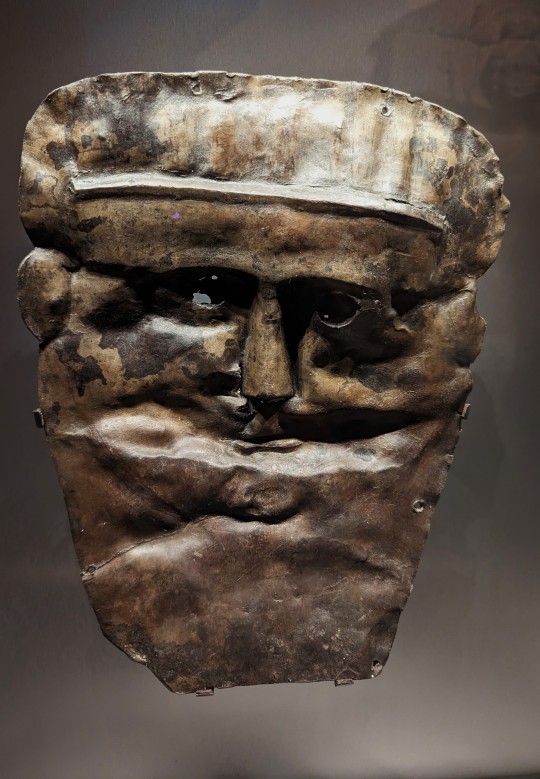
Religious Mask from Bath, England dated between the 1st and 4th Centuries on display at the Roman Baths Museum in Bath, England
Photographs taken by myself 2023
#art#archaeology#history#fashion#roman empire#england#english#ancient#iron age#roman baths museum#bath#barbucomedie
119 notes
·
View notes
Text


Annular Brooch Sisters
illustrations of brooches c21730 and c21730 from UNIMUS
#viking age#brooch#iron age#archaeology#illustration#norway#my art#reposting these but together#i really wish i made the backgrounds match
23 notes
·
View notes